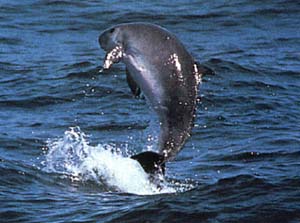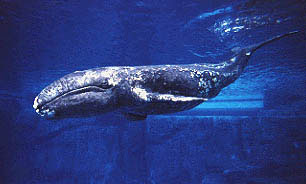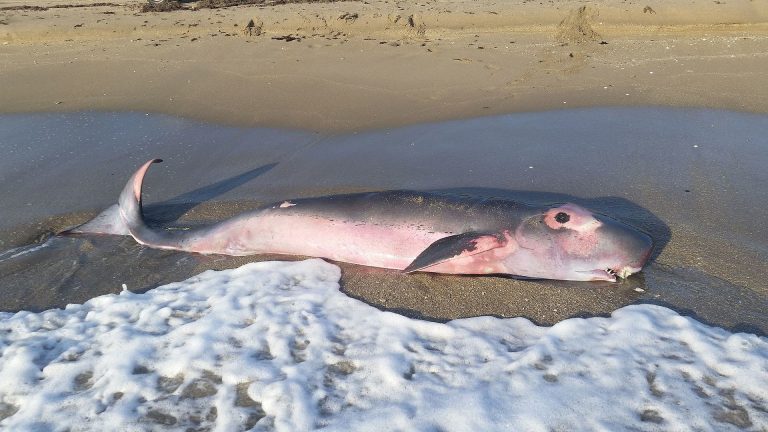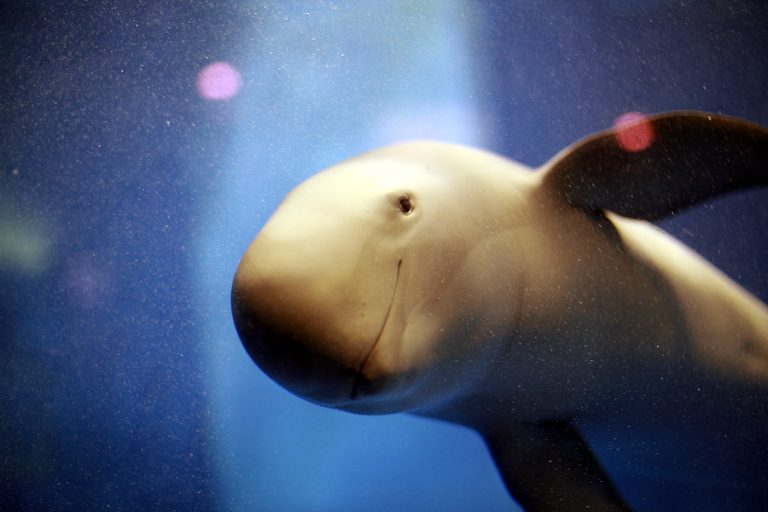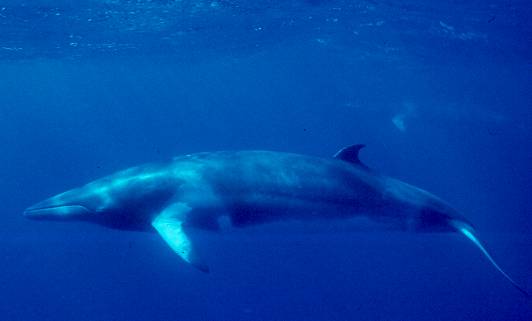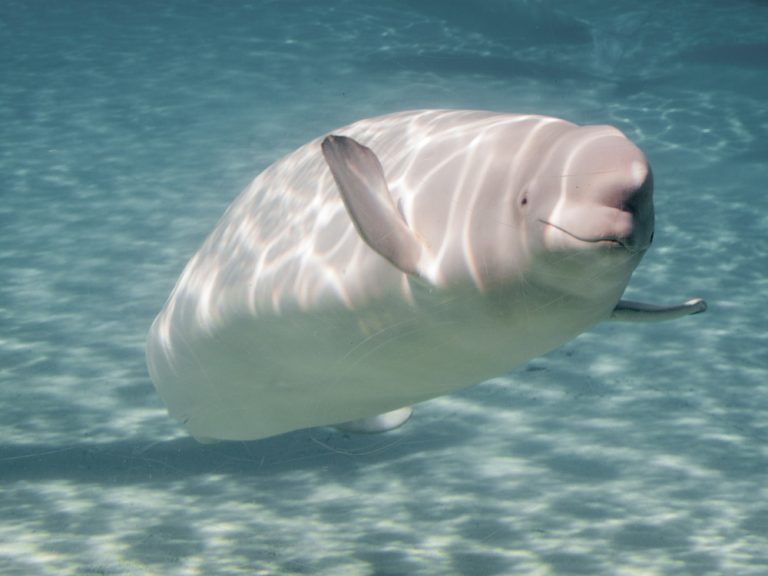Species Profile: The Beluga Whale
The Beluga Whale is one intriguing creature! Though it’s one of the smallest whales, it stands out everywhere.
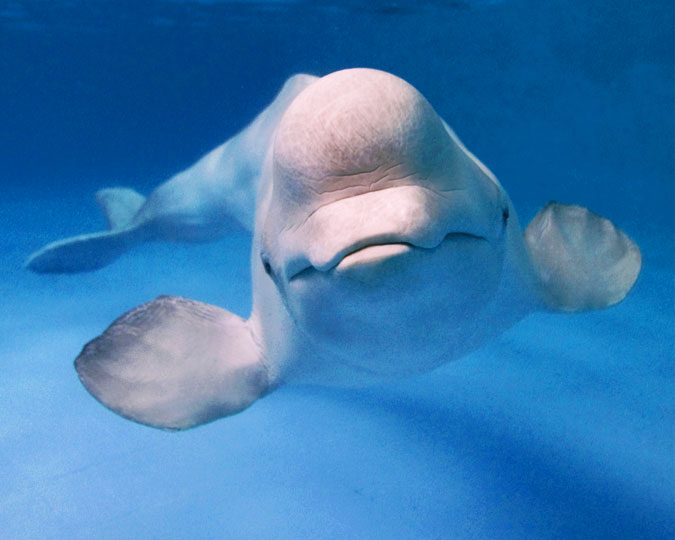
From the very first glance, the Beluga Whale stands out with its stark white color and friendly appearance.
This species is an Arctic and Sub-Arctic cetacean. Often called the white whale, the beluga shares the same family with the narwhal.
Its adaptation to life in the frigid waters of the Arctic means it has evolved several anatomical and physiological characteristics different from other cetaceans. For instance, its body has a high proportion of blubber, it lacks a dorsal fin, and has a stark all-white body color.
Also, its sharp sense of hearing and echolocation enables it move about under ice yet it can quickly find blowholes under the ice covering so it can breathe.
They are very distinct for a prominent and rounded forehead that houses a “melon.” This melon aids echolocation and changes shape when the animal is vocalizing.
This whale is very vocal and employs various clicks, whistles, and clangs to communicate. Actually, they are so vocal that people call them “sea canaries.”
The Beluga whale is a social mammal and you’ll often find them in groups of about 10 individuals. That number easily increases to hundreds and thousands in the summer months.
Although they swim relatively slowly, they are deep divers and individuals have been sighted as deep as 700 meters (2,300 feet) below the surface.
This whale is listed as Near Threatened by the IUCN though some specific populations (Alaska USA, and Ungava Bay Canada), are heading towards an endangered status.
Belugas are very common in aquariums, dolphinariums, and wildlife parks worldwide due to their popularity with the public.
1) Scientific Name
Delphinapterus Leucas
2) Scientific Classification:
- Kingdom: Animalia
- Phylum: Chordata
- Class: Mammalia
- Order: Cetacea
- Family: Monodontidae.
- Genus: Delphinaterus
- Species: Delphinapterus Leucas
3) Life Expectancy
The beluga whale has an average life span of 35 – 50 years.
4) Average/Maximum Length
From 3 meters to 5.5 meters (10 to 18 feet) long.
5) Average/ Maximum Weight
When fully grown, beluga whales on average weigh between 91 to 1588 kg (2000 to 3500 lbs.)
6) Maximum Swimming Speed
The maximum observed swimming speed of a beluga whale is about 17 mph (27.5 km/h) for short distances. Adults routinely swim at speed of about 2 to 6 mph (3 to 9 km/h) when at leisure.
7) Interaction With/Danger To Humans
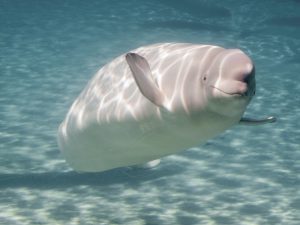
These whales are sensitive, friendly animals that work closely with humans.
In fact, they reportedly imitate human voices after staying with them for a while!
They can be commonly seen performing shows at local Aquariums and Marine Parks and interacting with people on a daily basis. Due to the fact that they are highly intelligent and friendly to people, they have become a staple for visitors who enjoy exploring and studying marine mammals.
As with most other whale species, belugas are generally non-violent. But of course they will attempt to defend themselves if they feel threatened.
8) Reproduction Details
Male beluga whales become sexually mature at about eight to nine years of age, and females at about four to seven years.
They usually breed in small bays during the spring or early summer and mate with many different partners. Their gestation lasts from 12 to 14 months and breeding females breed only once every two to four years.
Interestingly, group activities during birth are quite fascinating. When the female is in labor, many other female belugas come and act as “midwives” to help during the birth.
The calf can be born either tail or head first. Once the 4-foot calf is born, the “midwives” may help the young beluga to the surface for its first breath.
Thereafter, the calf must get milk from its mother for survival. The beluga whale produces green milk made up of 25 percent fat to help the calf form blubber to stay warm in the Arctic waters.
Other female beluga whales will gather round one of their kind in labor to act as “midwives.”
9) Diet/Hunting Pattern Of The Beluga Whale
In terms of food sources, the beluga whale is not particularly picky and it’s more of an opportunistic feeder. It is known to live on a diet of fish, crustaceans, krill, squid, octopus, crabs, sand worms and other small prey.
In order to maintain their energy these whales may consume on average between 2 and 3 percent of their body weight in food on a daily basis. Their young ones on the other hand are nursed on milk by their mother until they can hunt for food on their own.
Beluga whales often hunt for their prey at or near the bottom of shallow coastal shores and will hunt cooperatively in pods of 5 or more whales. This arrangement helps them herd prey together into tight balls where they can isolate and attack.
During deep dives the marine mammals can reach depths of up to 700 meters (2300 feet) when searching for food.
Belugas are opportunistic feeders and not particular about the species of fish they eat.
10) Alternative Names
- Belukha meaning “white one”
- White whale
- White Porpoise
- Sea Canary
- White Squidhound
11) Population And Conservation Status
Commercial whalers hunted the beluga whale during the peak of the whaling industry mainly during the 19th century and the early part of the 20th century.
Before then, some of the indigenous tribes of North America and Russia had been hunting belugas for centuries. And though whale hunting is now under international control since 1973, some of the native Inuit and Alaska groups are permitted to carry out subsistence hunting of belugas.
These whales like so many other large sea mammals are subject to many common threats like:
- Attack from predators like polar bears and killer whales.
- Contamination of rivers.
- Infectious diseases.
Though this whale was listed as Near Threatened by the IUCN in 2008, recent data implies that some sub-populations are now endangered and even critically endangered.
For example, the Cook Inlet in Alaska is now considered as critically endangered. While the eastern Hudson Bay and Ungava Bay populations (both in Canada) are endangered.
Presently, beluga whales number between 60,000 and 80,000 individuals worldwide.
12) Ancestry And History
This whale’s scientific name Delphinapterus Leucas is derived from Greek words meaning “white dolphin without a fin.”
Belugas are members of the toothed whale order. The beluga’s earliest known ancestor is the prehistoric Denebola Brachycephala, a now-extinct whale, from the late Miocene period (11.6 to 5.3 million years ago).
It shares a common ancestor with the narwhal and there is evidence of crossbreeding with narwhals.
13) Distribution and Habitat
These whales are common in the Arctic Ocean’s Coastal waters, though they are found in subarctic waters as well. Especially around North America, Russia and Greenland. Arctic belugas migrate southward in large herds when the sea freezes over.
They inhabit the Arctic Ocean and adjoining seas, including the sea of Okhotsk, the Bering Sea, the Gulf of Alaska, the Beaufort Sea, Baffin Bay, and the Gulf of St. Lawrence.
Some beluga populations make seasonal migrations while others remain in a relatively small area year round. Environmental conditions determine migration behavior.
This species is under pressure and at this rate, the general beluga whale population is likely to qualify for “Threatened” status within the next 5 years.

